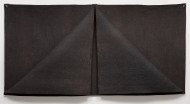
|
Robert Morris Robert Morris (artist) American, born 1931 Untitled, 1976 felt overall: 183 x 365.8 x 1.6 cm (72 1/16 x 144 x 5/8 in.) Gift of the Collectors Committee 2007.36.1 Not on View |
Robert Morris is perhaps the single most important figure for understanding the shift from minimal to postminimal art. As a pioneer of minimal sculpture during the early 1960s, Morris was one of the first artists to take into account the spatial and physical relationship between a viewer's body and a work of art. In columns, cubes, boxes, and L-beams, Morris's early works explored the body's interaction with specific objects and forms. As he explained in an interview with the critic E. C. Goossen, "I'm very much involved with that relationship towards things that has to do with the body's response."
By the late 1960s, Morris was already experimenting with what he termed "anti form." Turning away from the modular construction of his earlier sculptures, Morris began making works in materials such as felt, thread waste, and even steam in order to explore the unusual properties of these different media. In 1967 he began a series of works using industrial felt—seeing how it behaved when stacked, draped, folded, hung, cut into pieces, or dropped into a tangled heap. The following year Morris articulated the stakes of his new concerns in an Artforum essay titled "Anti Form," in which he stated: "Random piling, loose stacking, hanging, give passing form to the material. Chance is accepted and indeterminacy is implied since replacing will result in another configuration." What Morris was at pains to emphasize, in other words, is that a single "anti form" work holds the potential to take a different shape each time it is presented, based on the arbitrary behavior of the materials from which it is composed.
Untitled, 1976, is from the seminal Felts series. Although hung on a wall like a painting, this stubbornly tactile work compels both through its unpredictable form and its assertive physical presence, putting it in dialogue with National Gallery works by Eva Hesse and Richard Serra among others.

